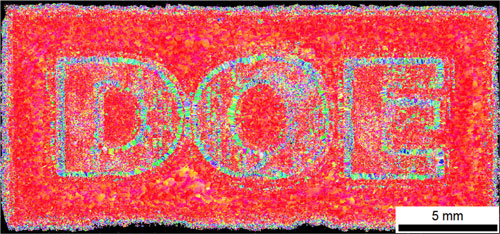Researchers at the Department of Energy’s Oak Ridge National Laboratory have demonstrated an additive manufacturing method to control the structure and properties of metal components with precision unmatched by conventional manufacturing processes.Ryan Dehoff, staff scientist and metal additive manufacturing lead at the Department of Energy’s Manufacturing Demonstration Facility at ORNL, presented the research this week in an invited presentation at the Materials Science & Technology 2014 conference in Pittsburgh.

ORNL researchers have demonstrated the ability to precisely control the structure and properties of 3-D printed metal parts during formation. The electron backscatter diffraction image shows variations in crystallographic orientation in a nickel-based component, achieved by controlling the 3-D printing process at the microscale.
“We can now control local material properties, which will change the future of how we engineer metallic components,” Dehoff said. “This new manufacturing method takes us from reactive design to proactive design. It will help us make parts that are stronger, lighter and function better for more energy-efficient transportation and energy production applications such as cars and wind turbines.”
The researchers demonstrated the method using an ARCAM electron beam melting system (EBM), in which successive layers of a metal powder are fused together by an electron beam into a three-dimensional product. By manipulating the process to precisely manage the solidification on a microscopic scale, the researchers demonstrated 3-dimensional control of the microstructure, or crystallographic texture, of a nickel-based part during formation.
Crystallographic texture plays an important role in determining a material’s physical and mechanical properties. Applications from microelectronics to high-temperature jet engine components rely on tailoring of crystallographic texture to achieve desired performance characteristics.
“We’re using well established metallurgical phenomena, but we’ve never been able to control the processes well enough to take advantage of them at this scale and at this level of detail,” said Suresh Babu, the University of Tennessee-ORNL Governors Chair for Advanced Manufacturing. “As a result of our work, designers can now specify location specific crystal structure orientations in a part.”
The above story is based on materials by medgadget.
Note: Materials may be edited for content and length. For further information, please contact the source cited above.
Copyright © 2024 International Society of Bionic Engineering All Rights Reserved
吉ICP备11002416号-1









